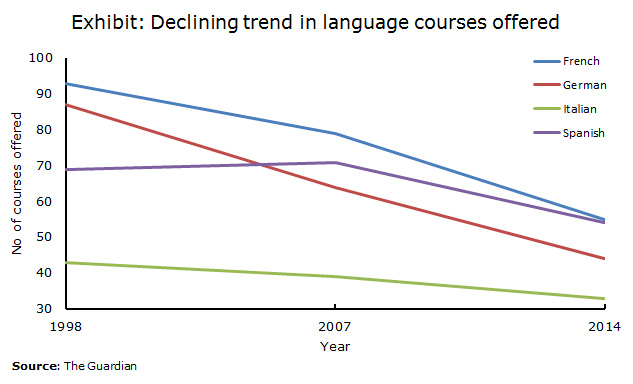M any educational institutions, that were founded long ago, would have started as a class of few students taught by a single master, covering maybe a couple of subjects. Harvard University started with nine students and a single master. Likewise, Samuel Johnson held the first classes in Columbia University with eight students in the class. Gradually, these institutions came to be revered next only to religious institutions as they grew in stature, size, and the number of disciplines offered. Over time, most of these institutions were offering all of the same courses; some of the courses might have lost their relevance but they still stayed.
Shifting focus of universities
Innovation in technologies and increasing globalization are the two major factors changing the face of education in the 21st century. The change is visible on both sides of the university admission counter. On one side, the student profiles enrolling in universities are changing rapidly – becoming more diverse demographically and geographically. On the other side, the universities are looking to keep-up with time, scrambling to stay relevant in this constantly-moving world. They are doing this by shifting their priorities on two key fronts:
The programs and courses being offered
The way these programs and courses are being delivered
The first point of concern for universities is the relevance of their programs and courses on offer.
Old technology or concepts either become obsolete or take a new shape and form every few decades. The first decade of twenty-first century has seen a sea-change in computing technology that has had a cascading effect on a lot of businesses. For example, social media and e-commerce – virtually non-existent over better part of the last century – are mainstays of today’s business world. With the advent of new technology, companies are under pressure to produce more for less to be able to compete effectively in the global marketplace. Companies continually question the relevance of old concepts, and try to invent new ones that can result in more quality and productivity. Industries share their feedback with universities on curricula either directly through industry-academia forums or indirectly through reduced job-offers to their students. Besides, they explicitly mention their requirements for the right skills in various job advertisements aimed at attracting prospective employees currently studying in universities.
For students seeking admission in prestigious universities, employability-post-education is a primary concern. Naturally they are looking to learn the skills expected of them by their future employers. So, the students prefer skill-based courses, which will make them ready for the job market, to basic knowledge-based courses, which are apparently lesser in demand by most industrial employers looking for ‘job-ready’ employees.
The academic institutions are expected to actively listen to feedbacks from students and employers, their prime stakeholders, and offer curricula in line with their requirements. A number of universities have swiftly responded to these changing preferences, and have undertaken comprehensive reviews of their programs and courses. For example, some universities are shifting their focus from courses based on art and culture to vocational courses. One such data point, observed by The Guardian, is the rate at which language degree courses are closing in the U.K. universities. Exhibit A shows the steady rate at which the courses pertaining to French, German, Italian, and Spanish languages have been closing down since 1998.

Universities cannot sustain the ongoing costs of modules that are less in demand. Unfortunately, easy targets for culling are those modules that are less biased in fetching jobs and are more expensive because you cannot replace say, a language teacher by a music teacher. Although, this shift in the focus is strongly debated by experts who say it is not a right thing to do, it seems to be the order of the day.
The second consideration for the educational institutions is the way their programs and courses are delivered.
The emergence and rapid percolation of internet worldwide has enabled the delivery of knowledge through a new channel – online – that was unheard of until the last decade. The name given to such a course delivered online over internet by education service providers is massive open online course (MOOC). One such organization that has taken MOOCs to a new level is Coursera (see www.coursera.org) that was launched barely a couple of years back. They have shown impressive growth within a short time-span and have already crossed enrolments of 10 million users. This splendid arrival can be attributed to the birth of a new demographic profile of students – an older professional desiring to pursue education but unable to do so in a traditional classroom setting. This new breed of students wants to be able to study anytime, anywhere at their own pace and convenience. Money is not their first concern as they are working professionals but moving away from job and family is, as they have family and kids.
Despite this overwhelming evidence, very few universities are offering online or even a blend of classroom and online teaching in their curricula. Universities simply can no longer close their eyes to the online presence. The new adult learner has money to dispense on tuition and fees, something that the universities are looking for with increasing privatization. What’s more, this new student is ready to learn at a fraction of the costs required of universities to spend on a traditional student learning in a college classroom. Suddenly, this seems like a very lucrative proposition for the universities. Also, they have the incredible performance of Coursera to vouch for. But hold on before you hurriedly join the MOOC bandwagon! Many universities have made a name for themselves because of a number of factors that are closely associated with physically attending the university. In some reputed campuses, it is more about the overall ‘student experience in these places’ than just the classroom learning. So, hastily shifting the scale in favour of MOOCs can spoil the party even before it can start.
This is where universities differ from one another and need to employ analytics to do a thorough study of their competitive advantage. The deep insights on why students prefer them can help them identify the right course offerings to be delivered online without cannibalizing their flagship courses. It will pave a way for their continued success in the future.
Related Posts:
- MOOC and the education system continuum
- Most important thing in analytics
- How Deliberate Strategy Can Be the Working Strategy!
<– Changing Student Demographics
Buy, Build, or Get the job done? –>
You can also subscribe to our blog – Our Perspectives – to receive interesting articles and tips in email. We would love to read your perspectives and comments on that.
Do follow Veravizion on LinkedIn, Twitter, Facebook, or Google+ to receive easy updates.
